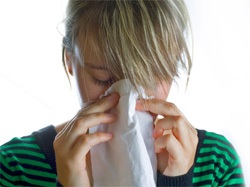Allergies: Yet Another Study Showing Acupuncture Effective for Allergic Rhinitis
Kristen Sparrow • March 12, 2013


A study in a major journal showing Acupuncture effectiveness for allergic rhinitis coming on the heels of the study discussed here. As my patients know, I was “cured” of my allergies with acupuncture, so it is one of my favorite things to treat. In this study nasal symptoms were significantly reduced in the Acupuncture group versus the sham group or the waitlist group. The “non-nasal” symptoms were improved in both sham and acupuncture groups. Not sure what those symptoms are. Alerted to this recent study from the NYTimes article here.
Allergy. 2013 Mar;68(3):365-74.
A multicenter, randomized, controlled trial testing the effects of acupuncture on allergic rhinitis.
Choi SM, Park JE, Li SS, Jung H, Zi M, Kim TH, Jung S, Kim A, Shin M, Sul JU, Hong Z, Jiping Z, Lee S, Liyun H, Kang K, Baoyan L.
Department of Medical Research, Korea Institute of Oriental Medicine, Daejeon, South Korea.
The aim of this study was to evaluate the efficacy and safety of acupuncture in the treatment for allergic rhinitis.
METHODS:
This study was a multicenter, randomized, parallel-controlled study. Participants were randomized to either the active acupuncture, sham acupuncture, or waitlist groups. The active and sham acupuncture groups received acupuncture treatment three times per week for 4 weeks. In the sham group, minimal acupuncture at nonacupuncture points was used. The waitlist group did not receive any acupuncture treatment.
RESULTS:
Of the 238 participants, 97, 94, and 47 individuals were assigned to the active acupuncture, sham acupuncture, and waitlist group, respectively. After the treatment, the difference in the total nasal symptom score (TNSS) was significantly reduced in the active acupuncture group compared with the sham acupuncture (difference: -1.03, 95% confidence interval [CI]: -1.96, -0.09, P = 0.03) and waitlist (difference: -2.49, 95% CI: -3.68, -1.29, P < 0.0001). The active acupuncture group exhibited a significant change in the total non-nasal symptom score (TNNSS) compared with the waitlist (difference: -0.78, 95% CI: -1.22, -0.34, P = 0.0002), but not the sham acupuncture group (difference; 0.15, 95% CI: -0.21, 0.5, P = 0.56). Both active and sham acupuncture treatments resulted in significant improvements in TNSS and TNNSS compared to baseline.
CONCLUSION:
Active acupuncture showed a significantly greater effect on symptoms of allergic rhinitis than either sham acupuncture or no active treatment. The symptoms of allergic rhinitis decreased significantly after treatment in the both acupuncture and sham acupuncture groups. Acupuncture appears to be an effective and safe treatment for allergic rhinitis.
http://www.ncbi.nlm.nih.gov/pubmed/23253122

